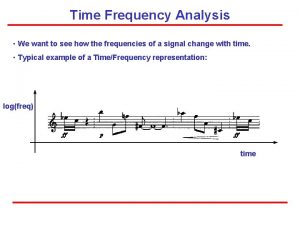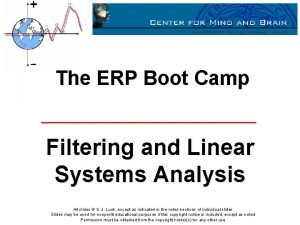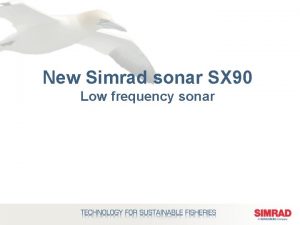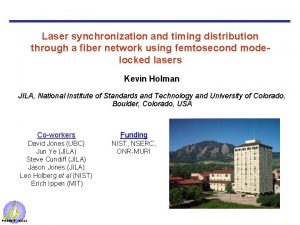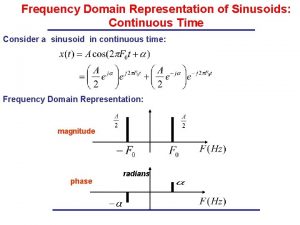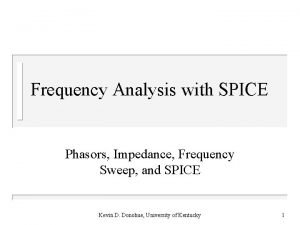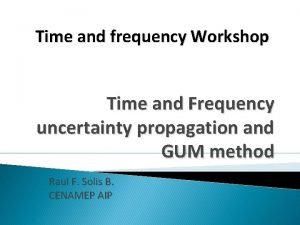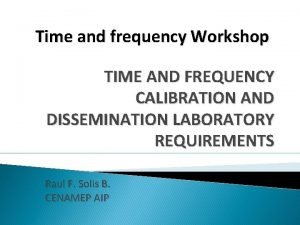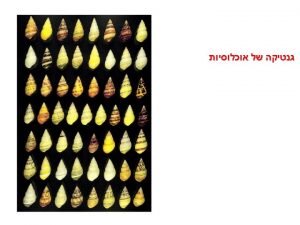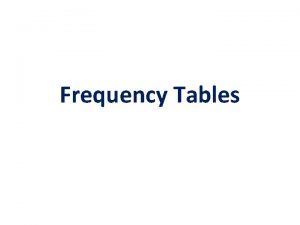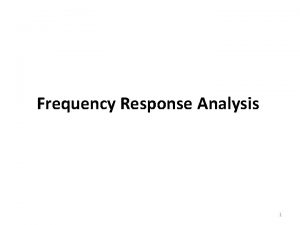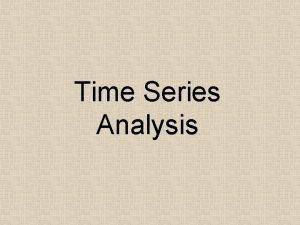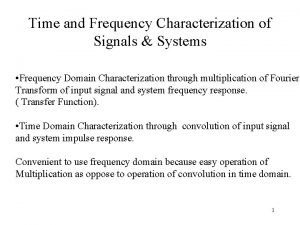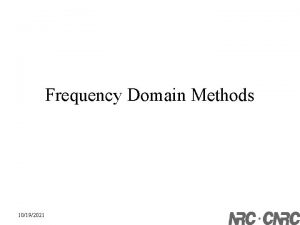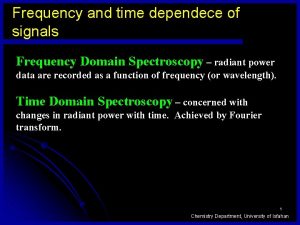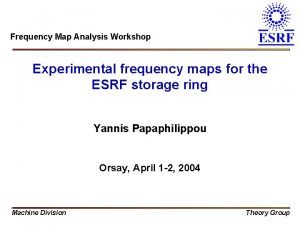Time Frequency Analysis We want to see how



























- Slides: 27

Time Frequency Analysis • We want to see how the frequencies of a signal change with time. • Typical example of a Time/Frequency representation: log(freq) time

Short Time Fourier Transform (STFT) • Given a signal we take the FFT on a window sliding with time

Spectrogram: ideally • The evolution of the magnitude with time is called Spectrogram. • Ideally we would like to have this: frequency time

Spectrogram: in practice • We need to deal with the effects of the window: main lobe and sidelobes frequency time

Spectrogram: effect of window length • Let N be the length of the window frequency time • Frequency Resolution • Time resolution: with m depending on the window;

Windows Rectangular Hamming Blackman

Time/Frequency Uncertainty Principle • either you have good resolution in time or in frequency, not both. either … or good localization in time. . . good localization in freq.

Example: a Chirp A “Chirp” is a sinusoid with time varying frequency, with expression If the frequency changes linearly with time, it has the form shown below: Frequency (Hz) Time (sec)

Chirp in Matlab Fs=10000; Ts=1/Fs; t=(0: 999)*Ts; y=chirp(t, 100, t(1000), 4000); plot(t(1: 300), y(1: 300))

Given Data Four repetitions of a chirp:

Spectrogram of the Chirp: no window spectrogram(y, rectwin(256), 250, 256, Fs, 'yaxis');

Spectrogram of the Chirp: hamming window spectrogram(y, hamming(256), 250, 256, Fs, 'yaxis');

Spectrogram of the Chirp: shorter window spectrogram(y, hamming(64), 60, 64, Fs, 'yaxis');

Spectrogram of the Chirp: shorter window spectrogram(y, hamming(64), 60, 256, Fs, 'yaxis');

Spectrogram of the Chirp: blackman window spectrogram(y, blackman(256), 250, 256, Fs, 'yaxis');

Sealion

Spectrogram of Sealion: hamming window spectrogram(y(2001: 12000), hamming(256), 250, 256, Fs, 'yaxis');

Spectrogram of Sealion: no window spectrogram(y(2001: 12000), rectwin(256), 250, 256, Fs, 'yaxis');

Spectrogram of Sealion: blackman, longer spectrogram(y(2001: 12000), blackman(512), 500, 512, Fs, 'yaxis');

Music spectrogram(y(2001: 12000), blackman(512), 500, 512, Fs, 'yaxis');

Spectrogram spectrogram(y(12001: 22000), hamming(256), 250, 256, 'yaxis');

Spectrogram: zoom spectrogram(y(12001: 22000), hamming(256), 250, 256, 'yaxis'); Not enough frequency resolution!

Frequencies we expect to see Since this signal contains music we expect to distinguish between musical notes. These are the frequencies associated to it (rounded to closest integer): Notes Freq. (Hz) C Db D Eb E F Gb G Ab A Bb B 262 277 294 311 330 349 370 392 415 440 466 494 Desired Frequency Resolution***: This yields a window length of at least N=1024 ***Note: the slide in the video has a typo, showing the inequality reversed.

Spectrogram: longer window spectrogram(y(12001: 22000), hamming(1024), 1000, 1024, 'yaxis');

Spectrogram: longer window (zoom) spectrogram(y(12001: 22000), hamming(1024), 1000, 1024, 'yaxis');

Spectrogram: recognize some notes spectrogram(y(12001: 22000), hamming(1024), 1000, 1024, 'yaxis'); Closest Notes: E: 330 Hz, 660 Hz D: 294 Hz, 588 Hz

Check with the Music Score E E B D D A
 Mathematics john's favourite subject
Mathematics john's favourite subject Lets decide
Lets decide Our father all of heaven roars your name lyrics
Our father all of heaven roars your name lyrics Relative frequency vs frequency
Relative frequency vs frequency Frequency vs relative frequency
Frequency vs relative frequency Constant phase difference
Constant phase difference Vmax shm
Vmax shm Relative frequency bar chart
Relative frequency bar chart Marginal frequency distribution
Marginal frequency distribution Marginal relative frequencies
Marginal relative frequencies Start time end time and elapsed time
Start time end time and elapsed time I want a wife analysis
I want a wife analysis We ______ snowman in winter.
We ______ snowman in winter. I want to hold your hand tempo
I want to hold your hand tempo Complete the sentences with if or when
Complete the sentences with if or when Data domain fundamentals
Data domain fundamentals Speed and agility frequency, intensity, time type
Speed and agility frequency, intensity, time type Time-frequency
Time-frequency Erp boot camp
Erp boot camp Sonar sx 9 review
Sonar sx 9 review Time frequency domain
Time frequency domain Frequency-domain
Frequency-domain Adverb of time and frequency
Adverb of time and frequency Is this a dagger soliloquy analysis
Is this a dagger soliloquy analysis The daffodils analysis
The daffodils analysis See-judge-act
See-judge-act Distribusi frekuensi data kualitatif
Distribusi frekuensi data kualitatif Frequency sweep analysis
Frequency sweep analysis

















